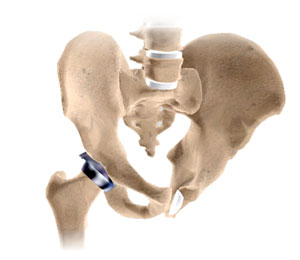Minimally Invasive Total Hip Replacement Surgeon in Westchester, Manhattan, Uniondale NY

Joint conditions such as arthritis may cause damage to the cartilage and bones leading to chronic pain in the hip and/or disability. The condition can be surgically treated by replacing the damaged parts with artificial components. Friedrich Boettner, MD provides expert diagnosis and minimally invasive hip replacement surgery in Westchester, Manhattan, Uniondale. Friedrich Boettner, MD also provides highly specialized care during and after the surgery. Contact Friedrich Boettner, MD’s office for an appointment today!

What is Minimally Invasive Total Hip Replacement?
Minimally invasive total hip replacement is a surgical procedure performed through one or two small incisions rather than the single long incision of 10–12-inches as in the traditional approach.
Hip Anatomy
The hip joint is one of the body's largest weight-bearing joints and is the point where the thighbone (femur) and pelvis (acetabulum) join. It is a ball-and-socket joint in which the head of the femur forms the ball and the pelvic acetabulum forms the socket. The joint surface is covered by a smooth articular cartilage that cushions and enables smooth movement of the joint.
Hip Arthritis
Hip arthritis is a painful and common disease of the hip joint caused by damage to the cartilage. Total hip replacement surgery is an option to relieve severe arthritis pain that limits your daily activities.
Minimally Invasive Total Hip Replacement Procedure
Surgery may be recommended in patients with severe cartilage damage and if conservative treatment options such as anti-inflammatory medications and physical therapy do not relieve the symptoms.
For minimally invasive hip replacement, the surgical technique and artificial implants remain the same as traditional hip replacement; the difference is the use of smaller incisions to perform the surgery and minimal soft tissue dissection. The surgery is performed through either one or two small incisions, under general anesthesia.
In a single incision minimally invasive approach, your surgeon makes a 3-6-inch incision over the side of your hip to expose the hip joint. The muscles are minimally dissected to reach the joint. The femur is dislocated from the acetabulum. The surface of the socket is cleaned and the arthritic bone is removed using a reamer. The acetabular implant is inserted into the socket using screws or special cement. A liner material of plastic, ceramic or metal is placed inside the acetabular component.
The femur or thigh bone is then prepared by removing the arthritic bone using special instruments and shaped to exactly fit the new metal femoral component. The femoral stem is then inserted into the femur either by a press fit or using bone cement. Then, the femoral head component made of metal or ceramic is placed on the femoral stem. The new joint is realigned. All the new parts are secured in place using special cement. The muscles and tendons around the new joint are repaired and the incision is closed.
If your surgeon uses the two-incision technique, a 2-3-inch incision is made over the groin for the placement of the socket and a 1-2-inch incision is made over the buttock for placement of the femoral stem. This technique requires a longer operative time and is performed under X-ray guidance. The rest of the procedure is the same as the single incision procedure.
Advantages of Minimally Invasive Total Hip Replacement
The advantages of minimally invasive total hip replacement as compared with traditional total hip replacement may include:
- Smaller incisions
- Lesser muscle dissection
- Minimal postoperative pain
- Shorter hospital stay
- Less trauma to the surrounding tissues
- Quicker recovery
- Less blood loss
- Less scarring
- Faster rehabilitation
Postoperative Precautions for Minimally Invasive Total Hip Replacement
After undergoing minimally invasive total hip replacement, you must take special care to prevent dislocation of the new joint and ensure proper healing.
- Avoid the combined movement of bending your hip and turning your foot inwards.
- Place a pillow between your legs while sleeping for 6 weeks.
- Never cross your legs and bend your hips past a right angle (90°).
- Avoid sitting on a low chair.
- Avoid bending down to pick up objects; instead, use a grabber device.
- Use an elevated toilet seat.
Risks and Complications of Minimally Invasive Total Hip Replacement
As with any major surgical procedure, there are certain potential risks and complications involved with total hip replacement surgery. They include:
- Infection
- Injury to neighboring nerves and blood vessels
- Formation of blood clots in the leg veins
- Implant malposition
- Fracture of the femur or pelvis
If you would like to have additional information on the treatment of hip arthritis or would like to learn more about minimally invasive total hip replacement, please contact Friedrich Boettner, MD serving the communities of Westchester, Manhattan, Uniondale.






